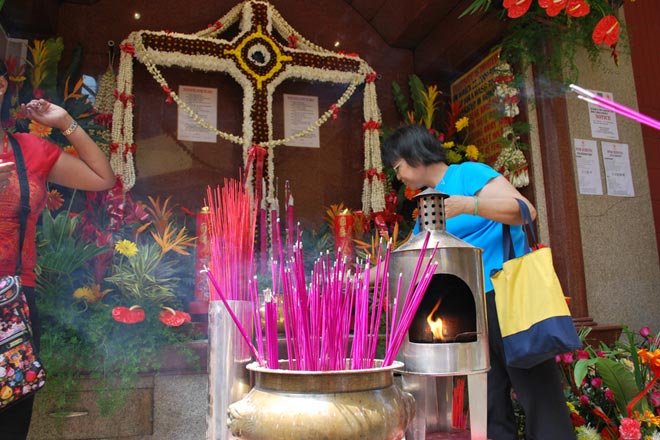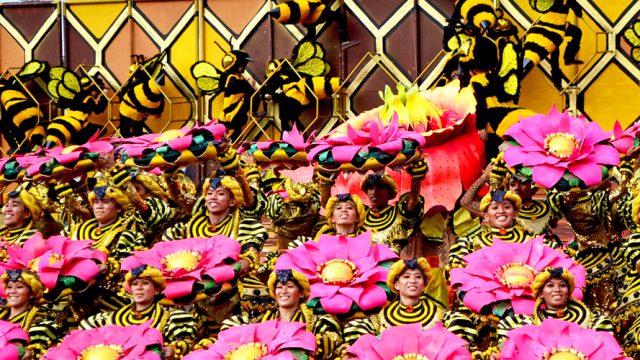Exploring Intramuros
The walled-city that the Spanish built in 1571 today offers a glimpse into Manila’s past
The Manila Cathedral is known for its stone carvings and stained glass art; outside the Cathedral is the Plaza de Roma, carved out of an earlier bullring. The San Agustin Church (do not miss the artwork on the roof of this popular wedding venue) and the San Agustin Museum are part of the UNESCO World Heritage Sites.
Casa Manila will remind you of the 19th century Spanish colonial mansions; you can take a picture with the guards and owners of the calesas (horse-drawn carriages) who go around dressed in period costumes.

Go on an art walk
The National Gallery of Art (part of the National Museum complex) showcases the classical artworks of 19th century Filipino artists, especially Juan Luna and Fernando Amorsolo. The Metropolitan Museum of Manila and the art galleries in the Cultural Centre of the Philippines are also known for their displays of modern art. Manila Contemporary often holds exhibitions of artists from home and abroad. The Intramuros area is an interesting place to study the colonial architecture. The Manila Metropolitan Theatre is a fine example of the Philippine’s Art Deco style.

Manila Ocean Park
A marine theme park, it consists of various marine life attractions and a hotel. Be a mermaid and swim like one at the Mermaid Swim Experience; walk through the Oceanarium; know about the jellyfishes at the Jelly Exhibit; take a ride in a glass-bottom boat; etc.

Museum mosaic
Museums in Manila have been built around themes that range from traditional to quirky. Start with the National Museum of the Filipino People located adjacent to tne National Museum Building. The biggest draw here is the skull cap of Tabon Man, who lived around 24,000 BC. There are displays on Filipino indigenous tribes, pre-Hispanic musical instruments and other artefacts, etc. You can also see the artefacts salvaged from the wreck of the Spanish galleon, San Diego, which sank in 1600. The Escolta Museum on Escolta Street speaks of the once flourishing architecture and lifestyle that existed here prior to the Second World War.
The Ayala Museum, founded by the Zóbel de Ayala family, displays works of artist Fernando Zóbel, gold artefacts dating back to the pre-Hispanic days, etc. The Yuchengco Museum houses the art collection of Ambassador Alfonso T. Yuchengco. If you have a shoe fetish, a visit to the Marikina Shoe Museum is a must – located in the heart of Manila’s shoemaking district, the museum displays the 800 pairs of shoes of Imelda Marcos. You can also take a look at the Coconut Palace from outside, mostly made of coconut-based material, another example of Imelda Marcos extravaganza.
On a religious note
If you are still looking for some religions solace after visiting the San Augustin Church, you can visit the Quiapo Church on Quezon Boulevard; rebuilt in 1933 after a fire destroyed the earlier building, it is known for its statue of Christ called the Black Nazarene. Greenbelt Chapel, located in Makati’s Greenbelt Park (Greenbelt is a luxury shopping complex), is a well-distinguished domed church.

Rizal Park
Also known as the Luneta National Park, it encloses wooded areas and open lawns, ornamental gardens and ponds, and a network of paved walkways. There are lots of attractions scattered throughout the park. The visitor centre at the Kalaw Avenue entrance provides a map of the park and details of upcoming events. Monuments dedicated to Filipino heroes dot the area called the Central Lagoon; there is also a dancing musical fountain here. The Rizal Monument, guarded by sentries in full regalia, marks the spot where Jose Rizal was executed; browse through the Rizal memorabilia displayed here. Every Sunday, around 5.30pm, the Concert at the Park takes place at the open-air auditorium; entry free. You can join the locals playing chess at the Chess Plaza.

Sunset by the sea
The Manila Bay is famous for its sunset views. Catch the sun going down from the Roxas Boulevard and then turn around to enjoy the evening at the bars and restaurants stretching along the Baywalk promenade, try your luck at the casinos and check out the nightly entertainment scene. Sunset cruises along the Manila Bay also available.
The Chinese Link
Binondo, Manila’s 400-year-old Chinatown, is another great corner to explore. Rummage through the vendors’ wares, try the array of Chinese food and then take a look at the Chinese cemetery, located north of Binondo, where you will find tombs with luxury amenities, including air-conditioning, kitchens, etc.

The Food Trail
Except Balut (boiled duck embryo), few Filipino dishes are known globally. But Filipino cuisine is no less interesting than that of its neighbouring countries. In Manila, besides Filipino dishes, you can also taste Chinese and Spanish food in Binondo and Intramuros areas, respectively. The Mall of Asia, said to be the third largest shopping mall in the world, has some good restaurants serving Filipino, Spanish, Chinese and other global cuisine. You will find a variety of cafes (along with music lounges and theatres) in Manila’s Malate district. And to cool off after some sightseeing, there is nothing better than ‘halo halo’, a popular Filipino dessert mainly consisting of shaved ice, milk and fruits. May be, you can round off your trip to Manila with a dinner cruise along the Manila Bay.
General information: Philippines Tourism has designated 2015 as Visit the Philippines Year
Philippines
Leave a Reply
You must be logged in to post a comment.





